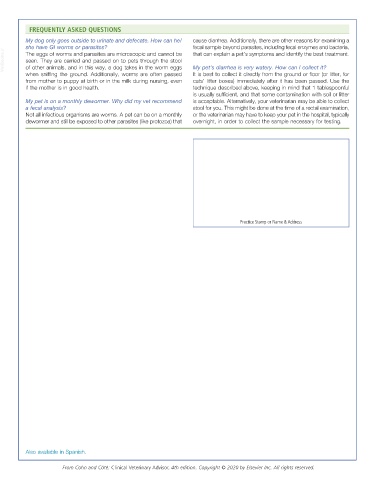Page 3188 - Cote clinical veterinary advisor dogs and cats 4th
P. 3188
FREQUENTLY ASKED QUESTIONS
My dog only goes outside to urinate and defecate. How can he/ cause diarrhea. Additionally, there are other reasons for examining a
she have GI worms or parasites? fecal sample beyond parasites, including fecal enzymes and bacteria,
VetBooks.ir seen. They are carried and passed on to pets through the stool My pet’s diarrhea is very watery. How can I collect it?
that can explain a pet’s symptoms and identify the best treatment.
The eggs of worms and parasites are microscopic and cannot be
of other animals, and in this way, a dog takes in the worm eggs
when sniffing the ground. Additionally, worms are often passed It is best to collect it directly from the ground or floor (or litter, for
from mother to puppy at birth or in the milk during nursing, even cats’ litter boxes) immediately after it has been passed. Use the
if the mother is in good health. technique described above, keeping in mind that 1 tablespoonful
is usually sufficient, and that some contamination with soil or litter
My pet is on a monthly dewormer. Why did my vet recommend is acceptable. Alternatively, your veterinarian may be able to collect
a fecal analysis? stool for you. This might be done at the time of a rectal examination,
Not all infectious organisms are worms. A pet can be on a monthly or the veterinarian may have to keep your pet in the hospital, typically
dewormer and still be exposed to other parasites (like protozoa) that overnight, in order to collect the sample necessary for testing.
Practice Stamp or Name & Address
Also available in Spanish.
From Cohn and Côté: Clinical Veterinary Advisor, 4th edition. Copyright © 2020 by Elsevier Inc. All rights reserved.

